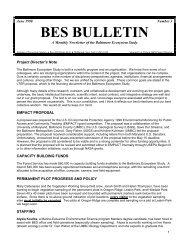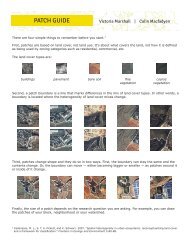Investigations in Urban Soils - Baltimore Ecosystem Study
Investigations in Urban Soils - Baltimore Ecosystem Study
Investigations in Urban Soils - Baltimore Ecosystem Study
You also want an ePaper? Increase the reach of your titles
YUMPU automatically turns print PDFs into web optimized ePapers that Google loves.
Draft 2 - (9.28.04)<br />
<strong>Soils</strong> <strong>Urban</strong> <strong>in</strong> <strong>Investigations</strong><br />
density, or number of adults be different? (note: preserved specimens can be weighed<br />
and a conversion factor used to calculate live biomass) (Szlavecz, per. Comm. 2004)<br />
It is <strong>in</strong>structive to look at the difference between air and soil temperature, especially <strong>in</strong><br />
habitats where they are different. In our first habitat, the air temperature (27ºC) would<br />
have been fatal for earthworms, but the soil temperature was cooler. This is one reason<br />
earthworms stay <strong>in</strong> the soil: its temperature, and moisture, fluctuate less rapidly than air.<br />
In our garden site, the soil temperature was warmer than the air for the same reason: it<br />
takes soil a few days to catch up to the air temperature, which it did few days later, at<br />
our last site.<br />
Personal communication by email with Dr. Katal<strong>in</strong> Szlavecz, Johns Hopk<strong>in</strong>s University,<br />
January 2004.<br />
page 38 <strong>Baltimore</strong> <strong>Ecosystem</strong> <strong>Study</strong><br />
– <strong>Investigations</strong> <strong>in</strong> <strong>Urban</strong> <strong>Soils</strong>






